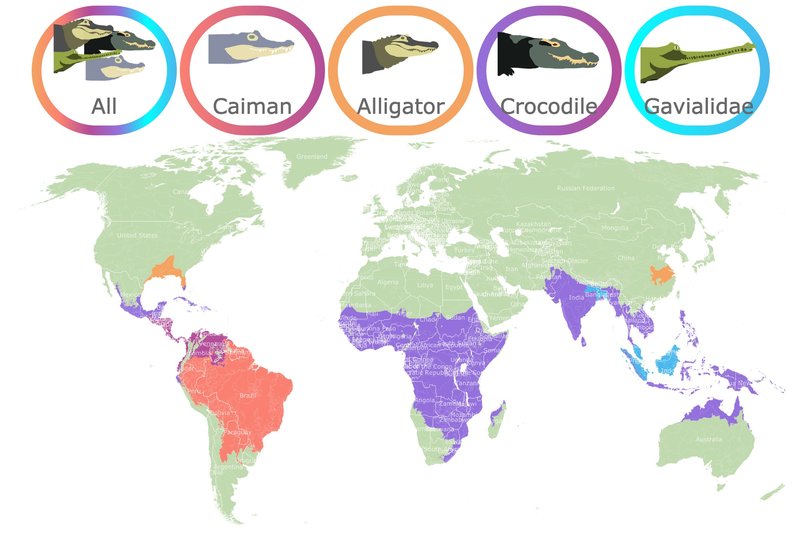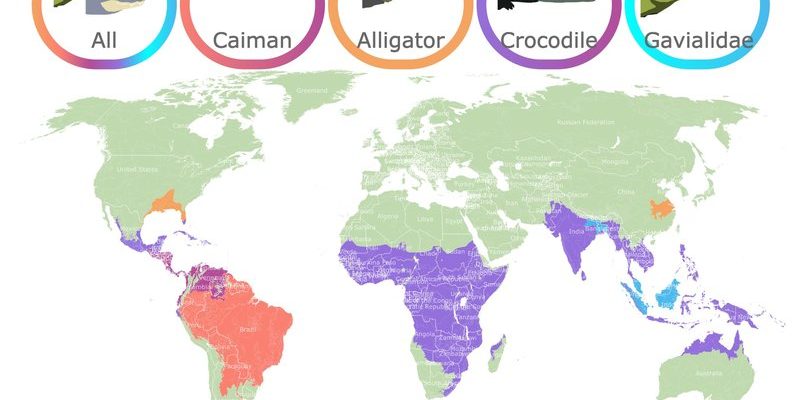
American crocodiles (Crocodylus acutus) aren’t just hanging out in any old body of water. They have unique habitats that help them thrive, often choosing brackish and saltwater environments. If you’re wondering how their habitats affect their distribution, you’re about to find out. Let’s explore their range, starting from their home in the Americas to places across the world.
Geographical Range of American Crocodiles
To understand where American crocodiles are found, it’s essential to start with their geographical range. These reptiles mainly inhabit the coastal areas of the Americas. From the United States to Central America and parts of the Caribbean, they have carved out a fascinating territory for themselves.
In the United States, you’ll find them primarily in Florida. The Everglades is a particularly notable site where these crocs thrive, enjoying the warm climate and abundant food supply. Moving south, their presence stretches down through Mexico, where they hang out in coastal lagoons and rivers.
Then there’s the Caribbean, where islands like Cuba and Jamaica host healthy populations of American crocodiles. They find perfect homes in mangroves and coastal wetlands, which offer not just shelter, but also hunting grounds.
American Crocodiles in the United States
Let’s zoom in on the United States. As mentioned, Florida is a hotspot for American crocodiles. These reptiles prefer the southern parts of the state, especially the Everglades National Park. But why Florida, you ask? The warm weather and a mix of freshwater and saltwater provide a perfect home. It’s like the Florida Keys were designed just for them!
In Florida, American crocodiles thrive in areas like:
- Coastal marshes
- Estuaries
- Swamps
These environments are rich in fish and crustaceans, which are key to their diet. American crocodiles are opportunistic feeders, and they hunt both in water and on land. You might even catch a glimpse of them sunbathing on riverbanks, soaking up the sun like any good Floridian would!
Central America and American Crocodiles
Heading south, American crocodiles find a comfortable home in Central America. Countries like Belize, Honduras, and Costa Rica are prime real estate. The warm climates and diverse ecosystems support their survival and reproduction.
In Belize, you can find them in the Cayes, where they enjoy lagoons teeming with fish. Honduras features mangroves that provide both safety and food. In Costa Rica, they inhabit various rivers and coastal areas, showcasing their adaptability.
The rich biodiversity of these regions allows American crocodiles to thrive. You might picture them nestled among the mangroves, patiently waiting for the perfect moment to strike. This adaptability is a key reason why they’ve persisted in these areas.
American Crocodiles in the Caribbean
Now, let’s talk about the Caribbean. This area is like the American crocodile’s vacation spot. Islands such as Cuba, Jamaica, and the Bahamas are incredibly important for their populations. These islands provide not just habitats, but also a variety of food sources.
In Cuba, for example, the Zapata Swamp is a notable habitat. Here, American crocodiles thrive among the dense vegetation. It’s a perfect mix of freshwater and saltwater reserves—ideal for nesting and hunting. On the other hand, Jamaica’s coastal wetlands also support their populations, though they face challenges from habitat loss.
You might be curious about how they navigate these islands. American crocodiles are surprisingly good swimmers, and they can travel between islands when conditions are right. Think of them as the island hoppers of the reptile world!
Conservation Challenges for American Crocodiles
While American crocodiles have adapted well to their environments, they face significant conservation challenges. Habitat loss due to urbanization and agriculture is a major issue in both the U.S. and Central America. As humans expand into their territories, these crocodiles lose crucial nesting sites and hunting grounds.
Pollution is another threat. It can drastically affect the food supply for American crocodiles. Toxic substances can accumulate in the water and harm their health. In some areas, hunting also poses a risk. Though many countries have protective measures in place, illegal hunting still happens.
Conservation efforts are crucial to ensure American crocodiles don’t face extinction. Organizations and governments are working to protect their habitats and raise awareness about these fascinating creatures. It’s like a team effort to keep the ecosystem balanced, and every bit helps!
How Do American Crocodiles Adapt to Their Environments?
Adaptability is a strong suit for American crocodiles, helping them survive in various environments. They are cold-blooded, which means they rely on external heat sources to regulate their body temperature. This adaptation allows them to thrive in both temperate and tropical regions.
When it comes to food, they’re opportunistic eaters. They hunt fish, birds, and even small mammals, which enables them to adapt their diet based on what’s available. Think of them as flexible eaters—whatever is on the menu!
Their physical features also help them adapt. With long, tapered snouts, they’re built for catching fish. Their powerful tails allow them to swim quickly and maneuver easily through water. This combination of features makes them formidable predators in their habitats.
American crocodiles are more than just fierce predators; they play a crucial role in their ecosystems. Found primarily in Florida, Central America, and the Caribbean, they’re fascinating creatures that adapt and thrive in various environments. While they face challenges, ongoing conservation efforts aim to protect their populations and habitats.
Next time you think about American crocodiles, picture them basking in the sun on a Florida riverbank or gliding through the mangroves of Belize. They’re survivors and skillful swimmers, making their mark in some of the most beautiful regions of the world. So, whether you’re planning a trip or just curious, you’ll now know where to find these remarkable reptiles!

